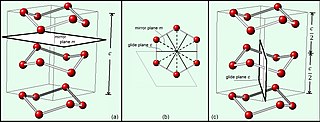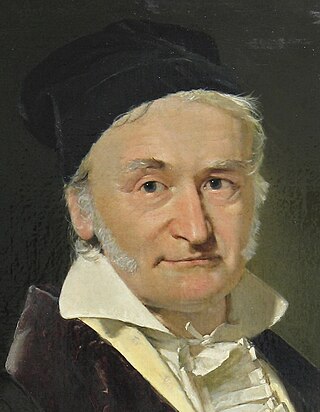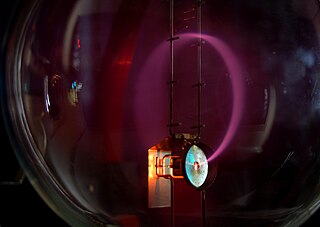This article consists of tables outlining a number of physical quantities.
The first table lists the fundamental quantities used in the International System of Units to define the physical dimension of physical quantities for dimensional analysis. The second table lists the derived physical quantities. Derived quantities can be expressed in terms of the base quantities.
Note that neither the names nor the symbols used for the physical quantities are international standards. Some quantities are known as several different names such as the magnetic B-field which known as the magnetic flux density, the magnetic induction or simply as the magnetic field depending on the context. Similarly, surface tension can be denoted by either σ, γ or T. The table usually lists only one name and symbol that is most commonly used.
The final column lists some special properties that some of the quantities have, such as their scaling behavior (i.e. whether the quantity is intensive or extensive), their transformation properties (i.e. whether the quantity is a scalar, vector, matrix or tensor), and whether the quantity is conserved.
| Base quantity | Symbol | Description | SI base unit | Dimension | Comments |
|---|---|---|---|---|---|
| Amount of substance | n | The quantity proportional to the number of particles in a sample, with the Avogadro constant as the proportionality constant | mole (mol) | N | extensive, scalar |
| Length | l | The one-dimensional extent of an object | metre (m) | L | extensive |
| Time | t | The duration of an event | second (s) | T | scalar, intensive, extensive |
| Mass | m | A measure of resistance to acceleration | kilogram (kg) | M | extensive, scalar |
| Temperature | T | Average kinetic energy per degree of freedom of a system | kelvin (K) | Θ or [K] | intensive, scalar |
| Electric Current | I | Rate of flow of electrical charge per unit time | ampere (A) | I | extensive, scalar |
| Angle | ∠ | the figure formed by two rays, called the sides of the angle, sharing a common endpoint, called the vertex of the angle. | degree (°) | ∠ BAC | extensive, scalar |
| Luminous intensity | Iv | Wavelength-weighted power of emitted light per unit solid angle | candela (cd) | J | scalar |
| Derived quantity | Symbol | Description | SI derived unit | Dimension | Comments |
|---|---|---|---|---|---|
| Absement | A | Measure of sustained displacement: the first integral with respect to time of displacement | m⋅s | LT | vector |
| Absorbed dose rate | D | Absorbed dose received per unit of time | Gy/s | L2T−3 | |
| Acceleration | a→ | Rate of change of velocity per unit time: the second time derivative of position | m/s2 | LT−2 | vector |
| Action | S | Momentum of particle multiplied by distance travelled | J/Hz | L2MT−1 | scalar |
| Angular acceleration | ωa | Change in angular velocity per unit time | rad/s2 | T−2 | |
| Angular momentum | L | Measure of the extent and direction of an object rotates about a reference point | kg⋅m2/s | L2MT−1 | conserved, bivector |
| Angular velocity | ω | The angle incremented in a plane by a segment connecting an object and a reference point per unit time | rad/s | T−1 | bivector |
| Area | A | Extent of a surface | m2 | L2 | extensive, bivector or scalar |
| Area density | ρA | Mass per unit area | kg⋅m−2 | L−2M | intensive |
| Capacitance | C | Stored charge per unit electric potential | farad (F = C/V) | L−2M−1T4I2 | scalar |
| Catalytic activity concentration | Change in reaction rate due to presence of a catalyst per unit volume of the system | kat⋅m−3 | L−3T−1N | intensive | |
| Centrifugal force | Fc | Inertial force that appears to act on all objects when viewed in a rotating frame of reference | N⋅rad = kg⋅m⋅rad⋅s−2 | LMT−2 | bivector |
| Chemical potential | μ | Energy per unit change in amount of substance | J/mol | L2MT−2N−1 | intensive |
| Crackle | c→ | Change of jounce per unit time: the fifth time derivative of position | m/s5 | LT−5 | vector |
| Current density | J → | Electric current per unit cross-section area | A/m2 | L−2I | conserved, intensive, vector |
| Dose equivalent | H | Received radiation adjusted for the effect on biological tissue | sievert (Sv = J/kg) | L2T−2 | intensive |
| Dynamic viscosity | v | Measure for the resistance of an incompressible fluid to stress | Pa⋅s | L−1MT−1 | intensive |
| Electric charge | Q | The force per unit electric field strength | coulomb (C = A⋅s) | TI | extensive, conserved |
| Electric charge density | ρQ | Electric charge per unit volume | C/m3 | L−3TI | intensive |
| Electric dipole moment | p | Measure of the separation of equal and opposite electric charges | C⋅m | LTI | vector |
| Electric displacement field | D→ | Strength of the electric displacement | C/m2 | L−2TI | vector field |
| Electric field strength | E→ | Strength of the electric field | V/m, N/C | LMT−3I−1 | vector field |
| Electrical conductance | G | Measure for how easily current flows through a material | siemens (S = Ω−1) | L−2M−1T3I2 | scalar |
| Electrical conductivity | σ | Measure of a material's ability to conduct an electric current | S/m | L−3M−1T3I2 | scalar |
| Electric potential | φ | Energy required to move a unit charge through an electric field from a reference point | volt (V = J/C) | L2MT−3I−1 | extensive, scalar |
| Electrical resistance | R | Electric potential per unit electric current | ohm (Ω = V/A) | L2MT−3I−2 | extensive, scalar, assumes linearity |
| Electrical resistivity | ρe | Bulk property equivalent of electrical resistance | ohm-metre (Ω⋅m) | L3MT−3I−2 | extensive, scalar, conserved |
| Energy | E | Energy | joule (J) | L2MT−2 | |
| Energy density | ? | Energy per volume | J⋅m−3 | L−1MT−2 | intensive |
| Entropy | S | Logarithmic measure of the number of available states of a system | J/K | L2MT−2Θ−1 | extensive, scalar |
| Force | F→ | Transfer of momentum per unit time | newton (N = kg⋅m⋅s−2) | LMT−2 | extensive, vector |
| Frequency | f | Number of (periodic) occurrences per unit time | hertz (Hz = s−1) | T−1 | scalar |
| Half-life | t1/2 | Time for a quantity to decay to half its initial value | s | T | |
| Heat | Q | Thermal energy | joule (J) | L2MT−2 | |
| Heat capacity | Cp | Energy per unit temperature change | J/K | L2MT−2Θ−1 | extensive |
| Heat flux density | ϕQ | Heat flow per unit time per unit surface area | W/m2 | MT−3 | |
| Illuminance | Ev | Wavelength-weighted luminous flux per unit surface area | lux (lx = cd⋅sr/m2) | L−2J | |
| Impedance | Z | Resistance to an alternating current of a given frequency, including effect on phase | ohm (Ω) | L2MT−3I−2 | complex scalar |
| Impulse | J | Transferred momentum | newton-second (N⋅s = kg⋅m/s) | LMT−1 | vector |
| Inductance | L | Magnetic flux generated per unit current through a circuit | henry (H) | L2MT−2I−2 | scalar |
| Irradiance | E | Electromagnetic radiation power per unit surface area | W/m2 | MT−3 | intensive |
| Intensity | I | Power per unit cross sectional area | W/m2 | MT−3 | intensive |
| Jerk | j→ | Change of acceleration per unit time: the third time derivative of position | m/s3 | LT−3 | vector |
| Jounce (or snap) | s→ | Change of jerk per unit time: the fourth time derivative of position | m/s4 | LT−4 | vector |
| Linear density | ρl | Mass per unit length | kg⋅m−1 | L−1M | |
| Luminous flux (or luminous power) | F | Perceived power of a light source | lumen (lm = cd⋅sr) | J | |
| Mach number (or mach) | M | Ratio of flow velocity to the local speed of sound | unitless | 1 | |
| Magnetic field strength | H | Strength of a magnetic field | A/m | L−1I | vector field |
| Magnetic flux | Φ | Measure of magnetism, taking account of the strength and the extent of a magnetic field | weber (Wb) | L2MT−2I−1 | scalar |
| Magnetic flux density | B | Measure for the strength of the magnetic field | tesla (T = Wb/m2) | MT−2I−1 | pseudovector field |
| Magnetic moment (or magnetic dipole moment) | m | The component of magnetic strength and orientation that can be represented by an equivalent magnetic dipole | N⋅m/T | L2I | vector |
| Magnetization | M | Amount of magnetic moment per unit volume | A/m | L−1I | vector field |
| Mass fraction | x | Mass of a substance as a fraction of the total mass | kg/kg | 1 | intensive |
| (Mass) Density (or volume density) | ρ | Mass per unit volume | kg/m3 | L−3M | intensive |
| Mean lifetime | τ | Average time for a particle of a substance to decay | s | T | intensive |
| Molar concentration | C | Amount of substance per unit volume | mol⋅m−3 | L−3N | intensive |
| Molar energy | J/mol | Amount of energy present in a system per unit amount of substance | J/mol | L2MT−2N−1 | intensive |
| Molar entropy | S° | Entropy per unit amount of substance | J/(K⋅mol) | L2MT−2Θ−1N−1 | intensive |
| Molar heat capacity | c | Heat capacity of a material per unit amount of substance | J/(K⋅mol) | L2MT−2Θ−1N−1 | intensive |
| Moment of inertia | I | Inertia of an object with respect to angular acceleration | kg⋅m2 | L2M | extensive, tensor, scalar |
| Momentum | p→ | Product of an object's mass and velocity | kg⋅m/s | LMT−1 | vector, extensive |
| Optical power | P | Measure of the effective curvature of a lens or curved mirror; inverse of focal length | dioptre (dpt = m−1) | L−1 | |
| Permeability | μs | Measure for how the magnetization of material is affected by the application of an external magnetic field | H/m | LMT−2I−2 | intensive |
| Permittivity | εs | Measure for how the polarization of a material is affected by the application of an external electric field | F/m | L−3M−1T4I2 | intensive |
| Plane angle | θ | Ratio of circular arc length to radius | radian (rad) | 1 | |
| Power | P | Rate of transfer of energy per unit time | watt (W) | L2M1T−3 | extensive, scalar |
| Pressure | p | Force per unit area | pascal (Pa = N/m2) | L−1MT−2 | intensive, scalar |
| Pop | p→ | Rate of change of crackle per unit time: the sixth time derivative of position | m/s6 | LT−6 | vector |
| (Radioactivity) Activity | A | Number of particles decaying per unit time | becquerel (Bq = Hz) | T−1 | extensive, scalar |
| (Radiation) Dose | D | Ionizing radiation energy absorbed per unit mass | gray (Gy = J/kg) | L2T−2 | |
| Radiance | L | Power of emitted electromagnetic radiation per unit solid angle per emitting source area | W/(m2⋅sr) | MT−3 | |
| Radiant intensity | I | Power of emitted electromagnetic radiation per unit solid angle | W/sr | L2MT−3 | scalar |
| Reaction rate | r | Rate of a chemical reaction for unit time | mol/(m3⋅s) | L−3T−1N | intensive, scalar |
| Refractive index | n | Factor by which the phase velocity of light is reduced in a medium | unitless | 1 | intensive, scalar |
| Reluctance | resistance to the flow of magnetic flux | H−1 | L−2M−1T2I2 | scalar | |
| Solid angle | Ω | Ratio of area on a sphere to its radius squared | steradian (sr) | ∠2 | |
| Specific energy | Energy density per unit mass | J⋅kg−1 | L2T−2 | intensive | |
| Specific heat capacity | c | Heat capacity per unit mass | J/(K⋅kg) | L2T−2Θ−1 | intensive |
| Specific volume | v | Volume per unit mass (reciprocal of density) | m3⋅kg−1 | L3M−1 | intensive |
| Spin | S | Quantum-mechanically defined angular momentum of a particle | kg⋅m2⋅s−1 | L2MT−1 | |
| Strain | ε | Extension per unit length | unitless | 1 | |
| Stress | σ | Force per unit oriented surface area | Pa | L−1MT−2 | order 2 tensor |
| Surface tension | γ | Energy change per unit change in surface area | N/m or J/m2 | MT−2 | |
| Temperature gradient | steepest rate of temperature change at a particular location | K/m | L−1Θ | vector | |
| Thermal conductance | κ (or) λ | Measure for the ease with which an object conducts heat | W/K | L2MT−3Θ−1 | extensive |
| Thermal conductivity | λ | Measure for the ease with which a material conducts heat | W/(m⋅K) | LMT−3Θ−1 | intensive |
| Thermal resistance | R | Measure for the ease with which an object resists conduction of heat | K/W | L−2M−1T3Θ | extensive |
| Thermal resistivity | Rλ | Measure for the ease with which a material resists conduction of heat | K⋅m/W | L−1M−1T3Θ | intensive |
| Torque | τ | Product of a force and the perpendicular distance of the force from the point about which it is exerted | newton-metre (N⋅m) | L2MT−2 | bivector (or pseudovector in 3D) |
| Velocity | v→ | Moved distance per unit time: the first time derivative of position | m/s | LT−1 | vector |
| Volume | V | Three dimensional extent of an object | m3 | L3 | extensive, scalar |
| Volumetric flow rate | Q | Rate of change of volume with respect to time | m3⋅s−1 | L3T−1 | extensive, scalar |
| Wavelength | λ | Perpendicular distance between repeating units of a wave | m | L | |
| Wavenumber | k | Repetency or spatial frequency: the number of cycles per unit distance | m−1 | L−1 | scalar |
| Wavevector | k→ | Repetency or spatial frequency vector: the number of cycles per unit distance | m−1 | L−1 | vector |
| Weight | w | Gravitational force on an object | newton (N = kg⋅m/s2) | LMT−2 | vector |
| Work | W | Transferred energy | joule (J) | L2MT−2 | scalar |
| Young's modulus | E | Ratio of stress to strain | pascal (Pa = N/m2) | L−1MT−2 | scalar; assumes isotropic linear material |
| spring constant | k | k is the torsional constant (measured in N·m/radian), which characterizes the stiffness of the torsional spring or the resistance to angular displacement. | N/m | MT−2 | scalar |












